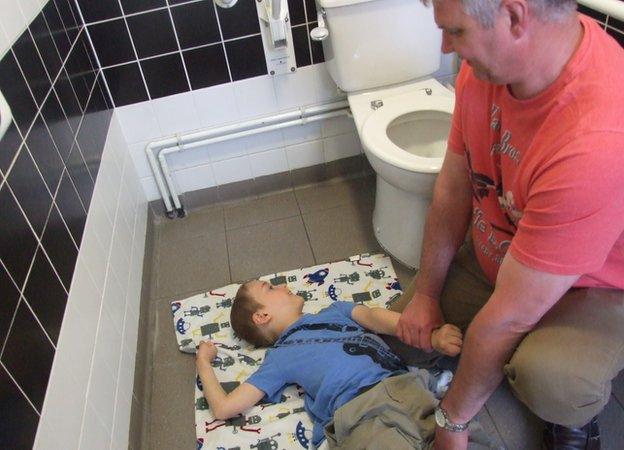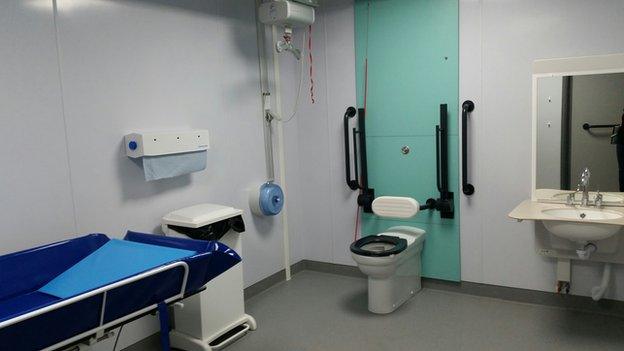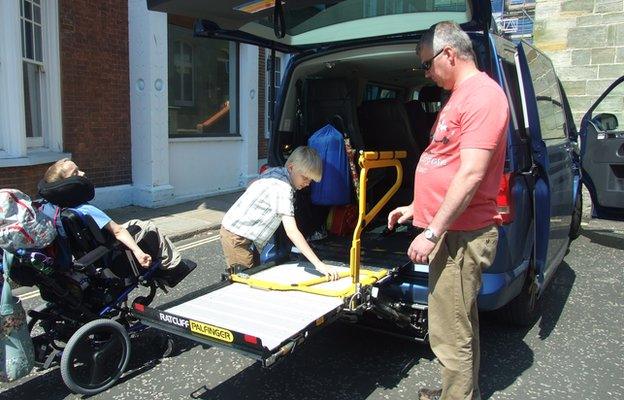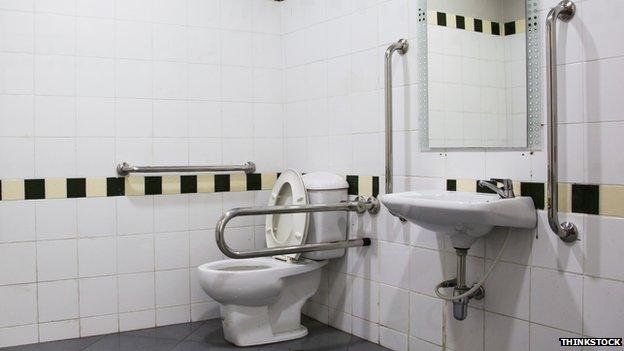'I change my disabled son's nappy on urine-soaked floors'
- Published

When faced with no suitable public toilets for her severely disabled son, Samantha Buck decided to take action.
"Some parents of disabled children don't like me saying this because it's not PC, but physically changing Alfie's nappy is like changing a giant baby," says Samantha Buck.
Alfie Buck is eight and is almost as tall as she is. He has quadriplegic cerebral palsy and is doubly incontinent.
"We changed him on a baby changer until he was five," Buck continues. "Then it started to get a bit heavy, a bit hard."
When they received a key from the council which allowed them to use accessible toilets in their area, the family were excited. Buck says she assumed there'd be "something that looks like a giant baby changer" inside, but was upset to find just a slightly wider room that's only suitable for people who are able to use it them by themselves - not for those who are less able and need assistance.
Buck says Alfie has to be changed rapidly - otherwise he quickly smells, and his faeces will begin leaking out of the side of his incontinence pad, into clothes and on to his wheelchair, which then takes a day and a night to dry out.
In order to change Alfie in a standard accessible toilet, Buck has to "heave him out of his wheelchair and drag him onto the floor", ensuring that she remembers to put a mat down first because toilet floors are often muddy and urine-soaked. Then she has to put Alfie's wheelchair outside the door to make enough room. She worries every time that his wheelchair will be stolen and she won't be able to get him home.
"If there is somebody with me to help, they can pass wipes and nappy sacks through the open door," she says. "Otherwise I have to get up off the floor and leave Alfie lying there with his arms and legs flying all over the place. It's just awful."
With more space and a changing bench, she says, the process would not be so degrading.
Though he can't talk, Alfie doesn't have a learning disability and Buck says she can tell what he wants to communicate by the sounds he makes, or through his eye movements - one way for "yes" the other way for "no". She can tell he feels uncomfortable and is embarrassed when he has to be changed in unsuitable situations.

The Changing Places toilet
At home Alfie is learning to communicate with words using a computer which he can control with his eyes and his mum says he loves family trips out in their accessible van.
The van is important to their family, Buck explains. With only 700 suitable public facilities in the UK, they often have to change Alfie in the back of it - and because the van is too tall to get through barriers at multi-story car parks, changing pads mostly happens whilst parked on a street.
When she asked other people in her situation how they get around the toilet problem, they told her they just don't go out. But with two other children, Buck says this isn't an option for her family. "It's shopping, meeting people, days out and hospital appointments. It's about living," she says.
The Changing Places, external campaign, led by learning disability charity Mencap, works to get more suitable toilet facilities installed for people like Alfie, whose needs aren't met by regular accessible loos. The campaign estimates that nearly a quarter of a million people in the UK with "severe disabilities" could benefit.
At 12 square metres, official Changing Places toilets are much bigger than the average accessible loo. They contain a hoist to lift a person from their wheelchair, and a full-sized adjustable changing bench for those who are incontinent, or to help those with limited movement undress before being hoisted to the toilet.
Seven UK airports, including Stansted and Heathrow have one, and some football stadiums such as the Emirates and Wembley. With 700 installed so far, the UK leads the way. Buck says thousands more are needed if they are to get out and about without meticulous planning.
"People just don't want to know," she says. "It's disgusting to them because you are talking about people pooing themselves. But it's an everyday reality for us."

The Bucks often have to change Alfie's nappy in the back of their van
After a long, hard struggle to get a Changing Places toilet installed in her local town of Horsham, Samantha took drastic action. "I ended up copying in the top councillors and our local MP, with photographs of Alfie lying on one of their toilet floors. I also copied in the West Sussex County Times, who picked up the story", she says.
"The council were embarrassed, so they had to do something." They said that an official Changing Places toilet would be too big and expensive to put in as equipment costs from £10-£15k, and then there are the varying installation costs depending on the setting.
Samantha did her homework to find the cheapest equipment and compromised on size. Now, she says there's an "as good as" toilet facility at her local swimming baths. The council says they were "delighted" to be able to identify a suitable, affordable location for the new toilet and are "committed to improving facilities for disabled people and their carers".
Their online map of official accessible facilities gets over 4,000 hits per month. The site also has listings of toilets which are good but don't meet their published criteria.
When out in Horsham at least, Buck is pleased that Alfie no longer has to suffer the indignity of being changed on a cramped and dirty toilet floor with the door ajar.

More from Ouch

How do you get in to an accessible toilet? It takes a large, conspicuous, silver-coloured key that opens more than 9,000 accessible toilets in the UK.

Follow @BBCOuch, external on Twitter and on Facebook, external, and listen to our monthly talk show